tow Citroen JUMPY 2016 2.G Owner's Guide
[x] Cancel search | Manufacturer: CITROEN, Model Year: 2016, Model line: JUMPY, Model: Citroen JUMPY 2016 2.GPages: 595, PDF Size: 12.47 MB
Page 200 of 595
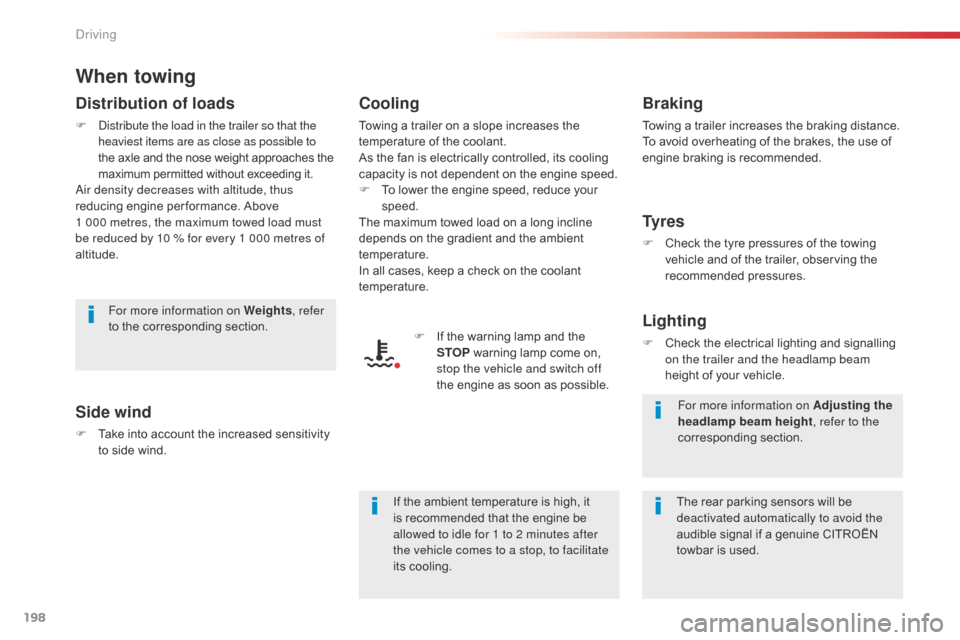
198
Jumpy _en_Chap06_conduite_ed01-2016
When towing
Distribution of loads
F Distribute the load in the trailer so that the heaviest items are as close as possible to
the axle and the nose weight approaches the
maximum permitted without exceeding it.
Air density decreases with altitude, thus
reducing engine per formance. Above
1
000 metres, the maximum towed load must
be reduced by 10
% for every 1 000 metres of
altitude.
Side wind
F Take into account the increased sensitivity to side wind.
Cooling
Towing a trailer on a slope increases the
temperature of the coolant.
As the fan is electrically controlled, its cooling
capacity is not dependent on the engine speed.
F
T
o lower the engine speed, reduce your
speed.
The maximum towed load on a long incline
depends on the gradient and the ambient
temperature.
In all cases, keep a check on the coolant
temperature.
F
I
f the warning lamp and the
STOP warning lamp come on,
stop the vehicle and switch off
the engine as soon as possible.
Braking
Towing a trailer increases the braking distance.
To avoid overheating of the brakes, the use of
engine braking is recommended.
Ty r e s
F Check the tyre pressures of the towing vehicle and of the trailer, observing the
recommended pressures.
Lighting
F Check the electrical lighting and signalling on the trailer and the headlamp beam
height of your vehicle.
For more information on Weights
, refer
to the corresponding section.
The rear parking sensors will be
deactivated automatically to avoid the
audible signal if a genuine CITROËN
towbar is used.
If the ambient temperature is high, it
is recommended that the engine be
allowed to idle for 1 to 2 minutes after
the vehicle comes to a stop, to facilitate
its cooling. For more information on Adjusting the
headlamp beam height
, refer to the
corresponding section.
Driving
Page 203 of 595
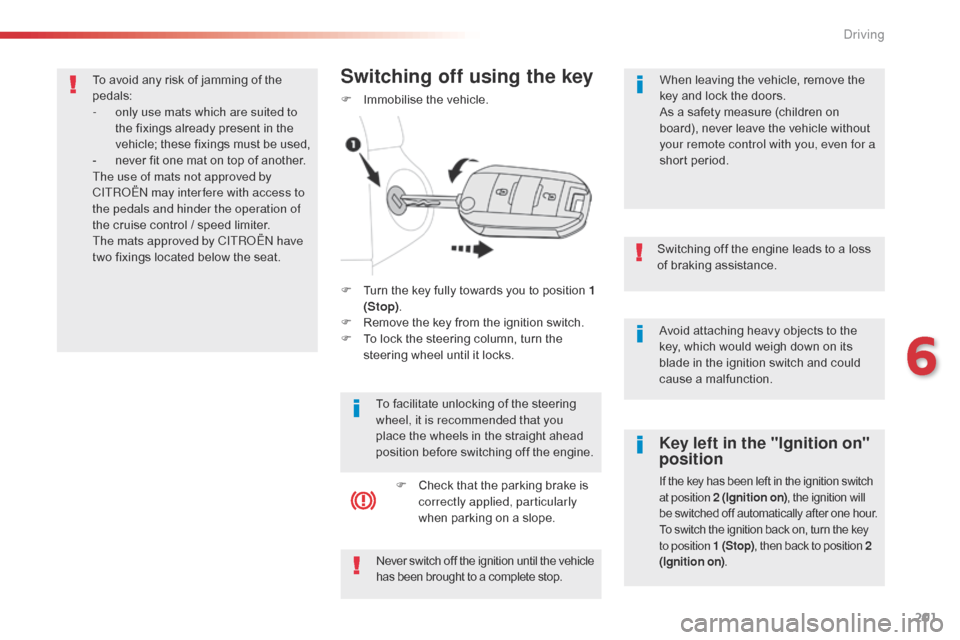
201
Jumpy _en_Chap06_conduite_ed01-2016
Avoid attaching heavy objects to the
key, which would weigh down on its
blade in the ignition switch and could
cause a malfunction.
Switching off the engine leads to a loss
of braking assistance.
Key left in the "Ignition on"
position
If the key has been left in the ignition switch
at position 2 (Ignition on)
, the ignition will
be switched off automatically after one hour.
To switch the ignition back on, turn the key
to position 1 (Stop) , then back to position 2
(Ignition on) .
Never switch off the ignition until the vehicle
has been brought to a complete stop.
F Turn the key fully towards you to position 1
(Stop) .
F
R
emove the key from the ignition switch.
F
T
o lock the steering column, turn the
steering wheel until it locks.
Switching off using the key
F Immobilise the vehicle.
To facilitate unlocking of the steering
wheel, it is recommended that you
place the wheels in the straight ahead
position before switching off the engine.F
C
heck that the parking brake is
correctly applied, particularly
when parking on a slope. When leaving the vehicle, remove the
key and lock the doors.
As a safety measure (children on
board), never leave the vehicle without
your remote control with you, even for a
short period.
To avoid any risk of jamming of the
pedals:
-
o
nly use mats which are suited to
the fixings already present in the
vehicle; these fixings must be used,
-
n
ever fit one mat on top of another.
The use of mats not approved by
CITROËN may inter fere with access to
the pedals and hinder the operation of
the cruise control / speed limiter.
The mats approved by CITROËN have
two fixings located below the seat.
6
Driving
Page 211 of 595

209
Jumpy _en_Chap06_conduite_ed01-2016
Automatic gearbox
Six speed automatic gearbox which offers
a choice between the comfort of automatic
operation or manual gear changing.
Two driving modes are offered:
-
a
utomatic operation for electronic
management of the gears by the gearbox,
-
m
anual operation for sequential changing
of the gears by the driver.Gear selector
P. Park.
F W ith your foot on the brake, turn the selector
to this position for parking or starting.
R.
R
everse.
F
T
urn the selector to this position.
N.
N
eutral.
F
T
urn the selector to this position for
starting.
D.
A
utomatic operation.
F
T
urn the selector to this position.
M.
M
anual operation with sequential gear
changing
F
Sel
ector in position D , press this button
then use the steering mounted control
paddles to change gear.
Steering mounted controls
The steering mounted control paddles
cannot be used to select neutral or to
select or come out of reverse.
When operating automatically, it remains
possible to change gear manually using the
steering mounted control paddles, when
overtaking, for example. Position N can be used in traffic jams or
in a car wash tunnel.
F
P
ull the right hand "
+" control paddle
towards you to change up.
F
P
ull the left hand "
-" control paddle towards
you to change down.
To turn the gear selector in complete
safety, it is recommended that you keep
your foot on the brake.
6
Driving
Page 216 of 595

214
Jumpy _en_Chap06_conduite_ed01-2016
Electronic gearbox
R. Reverse
F T urn the selector to this position.
N.
N
eutral.
F
W
ith your foot on the brake, turn the
selector to this position for starting.
A.
A
utomatic operation.
F
T
urn the selector to this position.
M.
M
anual operation with sequential gear
changing.
F
T
urn the selector to this position, then use
the steering mounted control paddles to
change gear.
Gear selector
F Pull the right hand " +" control paddle
towards you to change up.
F
P
ull the left hand " -" control paddle towards
you to change down.
Steering mounted control paddlesElectronically controlled gearbox which offers
a choice between the comfort of fully automatic
operation and manual gear changing.
There are two driving modes:
-
a
utomatic operation for automatic control
of the gears by the gearbox, without any
action on the part of the driver,
-
m
anual operation for sequential gear
changing by the driver using the steering
mounted paddles.
With automatic operation, you can temporarily
take over control of gear changing at any time.
The steering mounted paddles cannot
be used to select neutral or to select or
come out of reverse gear.
To turn the gear selector in complete
safety, it is recommended that you keep
your foot on the brake.
Driving
Page 237 of 595
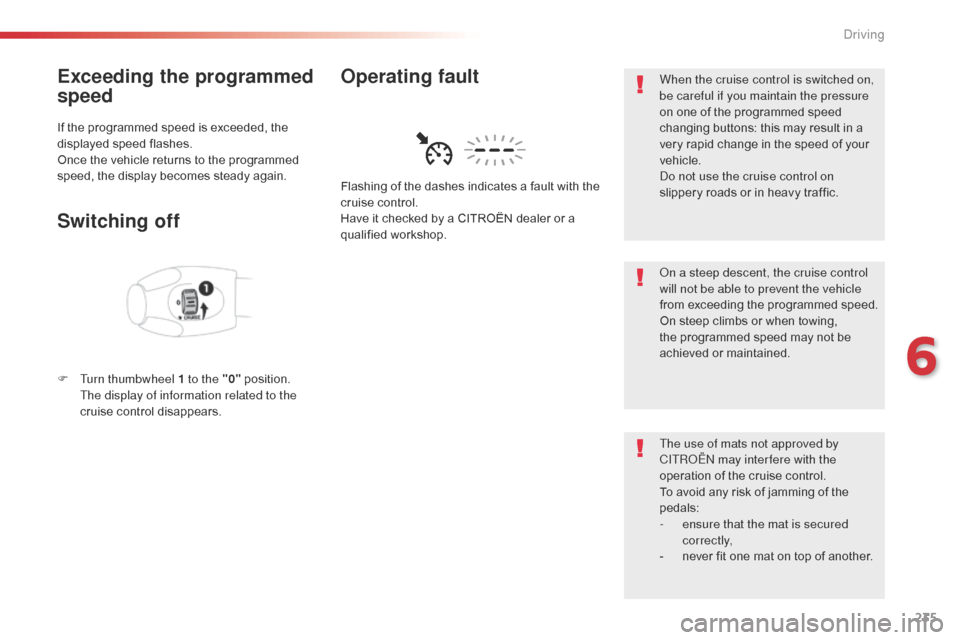
235
Jumpy _en_Chap06_conduite_ed01-2016
Exceeding the programmed
speed
If the programmed speed is exceeded, the
displayed speed flashes.
Once the vehicle returns to the programmed
speed, the display becomes steady again.
Switching off
F Turn thumbwheel 1 to the "0" position. T
he display of information related to the
cruise control disappears. Flashing of the dashes indicates a fault with the
cruise control.
Have it checked by a CITROËN dealer or a
qualified workshop.
Operating faultWhen the cruise control is switched on,
be careful if you maintain the pressure
on one of the programmed speed
changing buttons: this may result in a
very rapid change in the speed of your
vehicle.
Do not use the cruise control on
slippery roads or in heavy traffic.
On a steep descent, the cruise control
will not be able to prevent the vehicle
from exceeding the programmed speed.
On steep climbs or when towing,
the programmed speed may not be
achieved or maintained.
The use of mats not approved by
CITROËN may inter fere with the
operation of the cruise control.
To avoid any risk of jamming of the
pedals:
-
e
nsure that the mat is secured
c o r r e c t l y,
-
n
ever fit one mat on top of another.
6
Driving
Page 244 of 595
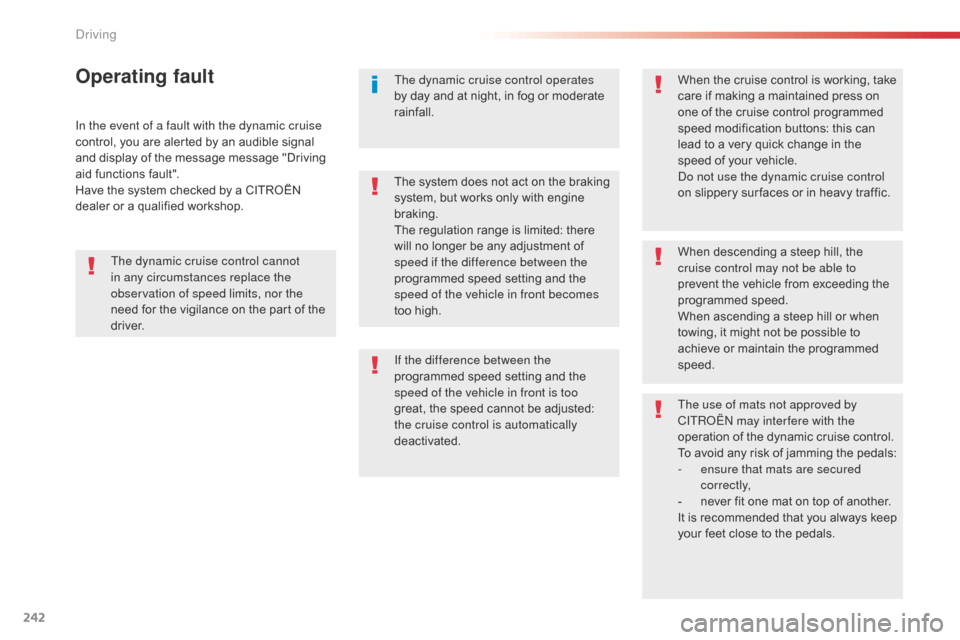
242
Jumpy _en_Chap06_conduite_ed01-2016
In the event of a fault with the dynamic cruise
control, you are alerted by an audible signal
and display of the message message "Driving
aid functions fault".
Have the system checked by a CITROËN
dealer or a qualified workshop.
Operating faultThe dynamic cruise control operates
by day and at night, in fog or moderate
rainfall.When the cruise control is working, take
care if making a maintained press on
one of the cruise control programmed
speed modification buttons: this can
lead to a very quick change in the
speed of your vehicle.
Do not use the dynamic cruise control
on slippery sur faces or in heavy traffic.
When descending a steep hill, the
cruise control may not be able to
prevent the vehicle from exceeding the
programmed speed.
When ascending a steep hill or when
towing, it might not be possible to
achieve or maintain the programmed
speed.
The use of mats not approved by
CITROËN may inter fere with the
operation of the dynamic cruise control.
To avoid any risk of jamming the pedals:
-
e
nsure that mats are secured
c o r r e c t l y,
-
n
ever fit one mat on top of another.
It is recommended that you always keep
your feet close to the pedals.
If the difference between the
programmed speed setting and the
speed of the vehicle in front is too
great, the speed cannot be adjusted:
the cruise control is automatically
deactivated. The system does not act on the braking
system, but works only with engine
braking.
The regulation range is limited: there
will no longer be any adjustment of
speed if the difference between the
programmed speed setting and the
speed of the vehicle in front becomes
too high.
The dynamic cruise control cannot
in any circumstances replace the
observation of speed limits, nor the
need for the vigilance on the part of the
driver.
Driving
Page 245 of 595
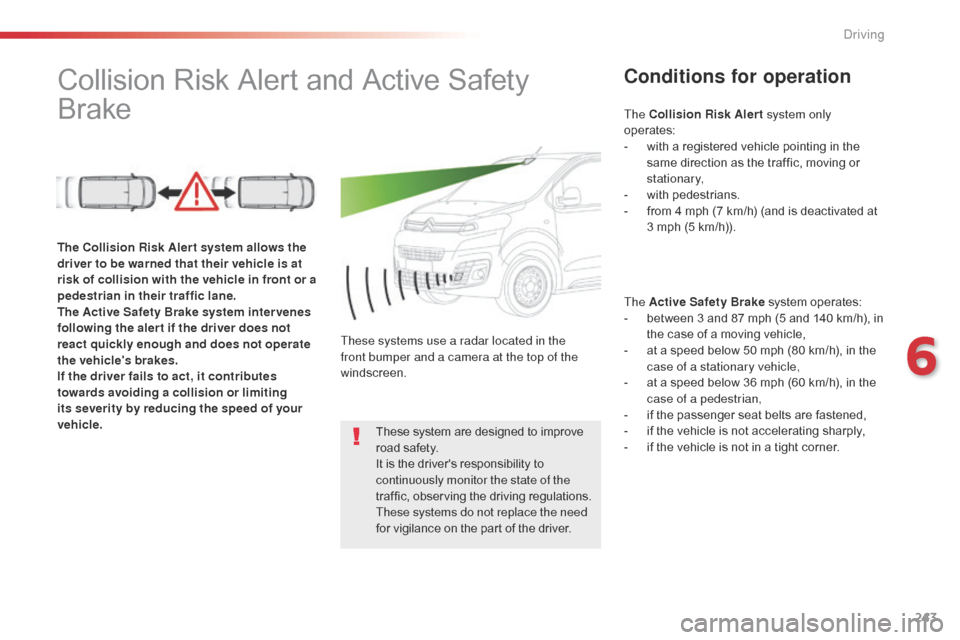
243
Jumpy _en_Chap06_conduite_ed01-2016
Collision Risk Alert and Active Safety
BrakeConditions for operation
The Active Safety Brake system operates:
- b etween 3 and 87 mph (5 and 140 km/h), in
the case of a moving vehicle,
-
a
t a speed below 50 mph (80 km/h), in the
case of a stationary vehicle,
-
a
t a speed below 36 mph (60 km/h), in the
case of a pedestrian,
-
i
f the passenger seat belts are fastened,
-
i
f the vehicle is not accelerating sharply,
-
i
f the vehicle is not in a tight corner.
The
Collision Risk Alert system allows the
driver to be warned that their vehicle is at
risk of collision with the vehicle in front or a
pedestrian in their traffic lane.
The Active Safety Brake system inter venes
following the aler t if the driver does not
react quickly enough and does not operate
the vehicle's brakes.
If the driver fails to act, it contributes
towards avoiding a collision or limiting
its severity by reducing the speed of your
vehicle. These systems use a radar located in the
front bumper and a camera at the top of the
windscreen.
These system are designed to improve
road safety.
It is the driver's responsibility to
continuously monitor the state of the
traffic, observing the driving regulations.
These systems do not replace the need
for vigilance on the part of the driver. The Collision Risk Alert
system only
operates:
-
w
ith a registered vehicle pointing in the
same direction as the traffic, moving or
stationary,
-
w
ith pedestrians.
-
f
rom 4 mph (7 km/h) (and is deactivated at
3 mph (5 km/h)).
6
Driving
Page 246 of 595
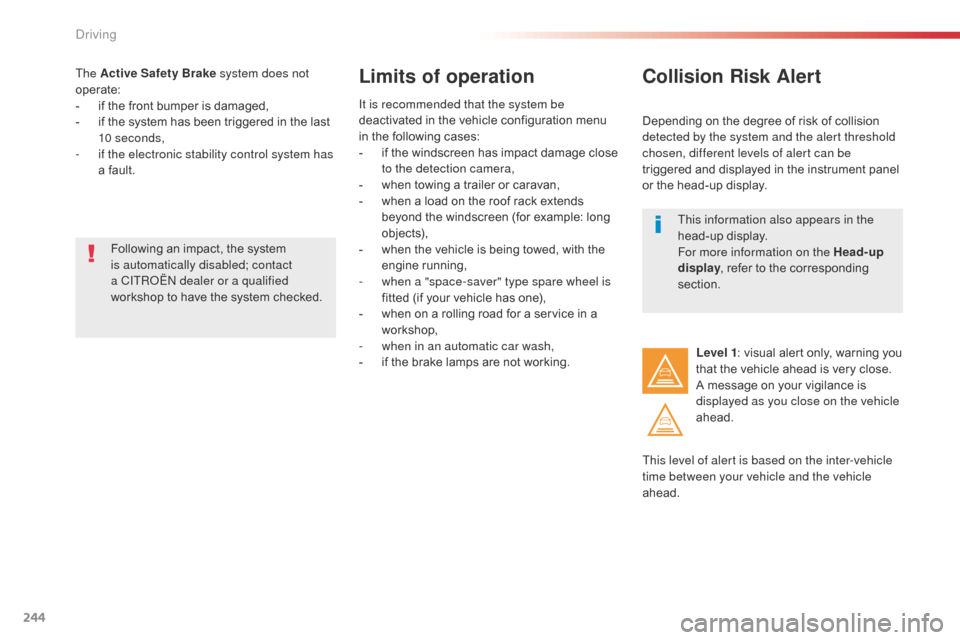
244
Jumpy _en_Chap06_conduite_ed01-2016
The Active Safety Brake system does not
operate:
-
i
f the front bumper is damaged,
-
i
f the system has been triggered in the last
10 seconds,
-
i
f the electronic stability control system has
a fault.Limits of operation
It is recommended that the system be
deactivated in the vehicle configuration menu
in the following cases:
-
i
f the windscreen has impact damage close
to the detection camera,
-
w
hen towing a trailer or caravan,
-
w
hen a load on the roof rack extends
beyond the windscreen (for example: long
objects),
-
w
hen the vehicle is being towed, with the
engine running,
-
w
hen a "space-saver" type spare wheel is
fitted (if your vehicle has one),
-
w
hen on a rolling road for a service in a
workshop,
-
w
hen in an automatic car wash,
-
i
f the brake lamps are not working.
Following an impact, the system
is automatically disabled; contact
a CITROËN dealer or a qualified
workshop to have the system checked.
Collision Risk Alert
Depending on the degree of risk of collision
detected by the system and the alert threshold
chosen, different levels of alert can be
triggered and displayed in the instrument panel
or the head-up display.
This level of alert is based on the inter-vehicle
time between your vehicle and the vehicle
ahead. Level 1
: visual alert only, warning you
that the vehicle ahead is very close.
A message on your vigilance is
displayed as you close on the vehicle
ahead.
This information also appears in the
head-up display.
For more information on the Head-up
display
, refer to the corresponding
section.
Driving
Page 256 of 595

254
Jumpy _en_Chap06_conduite_ed01-2016
Operating fault
Have it checked by a CITROËN dealer or a
qualified workshop.The system may suffer temporary
interference in certain weather
conditions (rain, hail...).
In particular, driving on a wet sur face
or moving from a dry area to a wet area
can cause false alerts (for example, the
presence of a fog of water droplets in
the blind spot angle is interpreted as a
vehicle).
In bad or wintry weather, ensure that
the sensors are not covered by mud,
ice or snow.
Take care not to cover the warning zone
in the door mirrors or the detection
zones on the front and rear bumpers
with adhesive labels or other objects;
they may hamper the correct operation
of the system.
Depending on your vehicle's equipment:
With the touch screen
In the Driving
menu, activate/deactivate " Blind
spot monitoring ".
In the event of a fault, these warning lamps
flash.
The indicator lamp in this button
flashes and a message appears,
accompanied by an audible signal.
The state of the system remains in
memory on switching off the ignition.
The system is automatically deactivated
when towing with a towbar approved by
CITROËN.
High pressure jet wash
When washing your vehicle, do not
place the tip of the lance within 30 cm
of the sensors as otherwise there is a
risk of damaging them.
or
Driving
Page 258 of 595

256
Jumpy _en_Chap06_conduite_ed01-2016
Front parking sensors
As an addition to the rear parking sensors, the
front parking sensors are triggered when an
obstacle is detected in front and the speed of
the vehicle is still below 6 mph (10 km/h).
The front parking sensors are interrupted if
the vehicle stops for more than three seconds
in for ward gear, if no further obstacles are
detected or when the speed of the vehicle
exceeds 6 mph (10 km/h).
With the audio system
Deactivation / Activation
Deactivation or activation of the system is done
via the vehicle configuration menu.
The sound from the speakers (front or
rear) indicates whether the obstacle is
in front or behind. The system will be automatically
deactivated where a towbar or towbar-
mounted bicycle carrier is fitted
(vehicle fitted with a towbar installed as
recommended by a CITROËN dealer).
In the " Personalisation-configuration " menu,
activate/deactivate " Parking assistance ".
With the touch screen
In the Driving menu, activate/deactivate
" Parking sensors ".
Without audio system
To deactivate the system:
F
P
ress the button, its indicator
lamp comes on, the systrem is
deactivated.
To activate the system: F
P
ress this button, the indicator
lamp goes off, the system is
activated.
Driving